MaxPreps looks at 10 teams that would have success in an opening-round NCAA tournament game.
Editor's note: This is a story that has been updated since its first release in March of 2008. Since the NCAA Men's Basketball Division I Tournament expanded to 64 teams in 1985 (and later to 65 teams in 2001 and now 68), there have been countless Cinderella stories each March.
Occasionally, it's an inconsistent team from a power conference that finally puts the pieces together for a deep tournament run. Other times, mid-major teams shock name-brand schools and find themselves playing beyond the first weekend.
If previously struggling teams from major conferences and little known programs from smaller leagues can surprise heavily favored squads in a fit of March Madness, couldn't some of the historically great high school teams do the same?
MaxPreps Senior Writer Stephen Spiewak thinks so, and looks at the top 10 high school teams that would've fared well amid the chaos of March Madness.
10. 1999 Rice (New York City)Perennial New York City powerhouse Rice has seen its share of basketball prodigies. The small Catholic school, located in Harlem, has been home to Sports Illustrated cover-boy Felipe Lopez, late blossoming scoring machine Keydren Clark, and current Big East point guards Edgar Sosa and Kemba Walker.
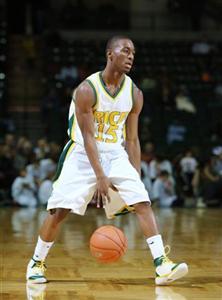
Kemba Walker starred at Rice before
graduating in 2008. The school's best
squad, however, may have been its
1999 team.
Photo by Lisa Yen
The school's 1999 team featured none of these players, but still may have had the best shot of beating a successful college team.
The Raiders' best player that year was Kenny Satterfield, a gritty playmaker who personified the New York City point guard archetype, later developing a reputation for his performances in streetball games. He was the NYSSWA state player of the year, displaying a mix of mental and physical attributes.
As if having the best high school player in talent-rich New York City doesn't make a team a threat to win a tournament game, Rice also featured super talented junior guard Andre Barrett.
The 5-8 Barrett was part of Seton Hall's landmark recruiting class that featured Marcus Toney-El and Eddie Griffin. He led the team to the second round of the tournament in 2004, and with the help of Kyle Cuff and Andre Sweet, could've done the same for the 1999 Rice team.
Cuff was a 6-7 forward who played for St. John's. Sweet was an inch shorter and had a leaner build, and often flew under the radar. However, he was a two time All-City selection who made stops at Duke and Seton Hall in his collegiate career.
Kenny Bell was also a valuable contributor overshadowed by the likes of Barrett and Satterfield.
The Raiders captured the coveted CHSAA crown, beating long time rival Christ the King*. The team then went on to capture the New York Federation state title behind 32 points from Satterfield and 19 from Barrett.
Finishing 27-1, many people pegged Rice as the country's top team. Finishing atop USA Today's national rankings, which were compiled by current MaxPreps Senior Writer Dave Krider, was another team however, Oak Hill Academy (Va.). But the Warriors needed overtime to edge Christ the King by two points, whereas the Raiders won by double figures.
If they got to set the pace of the game and pushed the tempo, the 1999 Rice Raiders would have challenged many of the teams in the bracket's first round.
*NOTE: In 1996, Christ the King's team was thought to be the city's best in more than a decade. It featured Lamar Odom, Speedy Claxton, and Erik Barkley. However, that squad was upset by a less talented Rice team that went on to win the state title. Still, the 1996 Christ the King squad no doubt would have given a scare to several tournament teams.
Continue reading{PAGEBREAK}
9. 2002 Lincoln (Dallas)Texas high school football is well-acclaimed, but Texas high school hoops is not too shabby either. However, the Lone Star State's basketball is often overshadowed by its football, and sometimes its baseball.
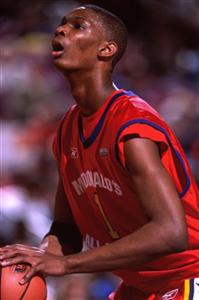
Chris Bosh was one of two
McDonald's All-Americans on
Lincoln's 2002 team.
Photo courtesy of Golin Harris
With the recent success of teams like Duncanville, South Oak Cliff and Yates, fans nationally have started to pay more attention to teams from Texas. However, the fact that more people are noticing Texas sports from January through March has a lot to do with the 2002 Lincoln team from Dallas.
After a stunning loss in the 4A semifinals in 2001, the Tigers were hungrier than ever. Led by McDonald's All-Americans Chris Bosh, an imposing presence down low, and Bryan Hopkins, an athletic point guard who was equally dangerous distributing the ball or elevating high for a dunk, Lincoln overcame every hurdle it faced.
One such hurdle the team got by was a regular season game against The Colony (Texas), which featured both Deron Williams and Bracey Wright, who was the more highly touted player at the time and also a McDonald's All-American.
Coach Leonard Bishop's squad also won games in Missouri and Louisiana in the 2002 season, but the team's in-state conquests are perhaps its most convincing. It beat the state's top 5A team, Cedar Hill, which was also ranked high nationally, in front of nearly 17,000 fans.
Come playoff time, the Tigers proved their mettle once more, hammering Beaumont Ozen and their future NBA draft pick, Kendrick Perkins, by the score of 71-51 in the 4A state title game.
Lest one thinks Lincoln was a two-man operation, it's worth noting that in addition to Bosh and Hopkins, 6-5 forward William Langrum was also named to the all-tournament team, in addition to netting second team all-state honors.
Guards Kevis Shipman (Baylor) and Jason Allen (Texas Southern) both played at the collegiate level; not to mention, future Oklahoma State Cowboy Byron Eaten was a freshman on the team.
A well balanced, accomplished and mentally fierce team were the 2002 Tigers, one of the few high school teams that could have been victorious in a tournament game.
Continue reading{PAGEBREAK}
8. 2005 Niagara Falls (N.Y.)When people think of the great basketball played in the Empire State, the playgrounds and cramped gyms of New York City often come to mind.
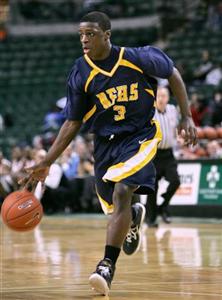
Before Syracuse, Johnny Flynn
first shared the court with Paul Harris
at Niagara Falls.
Photo by Kevin Yen
And rightfully so, as the Big Apple has produced more than its share of trophy players and teams.
Located nearly seven hours from Manhattan, Niagara Falls also lays claim to some high caliber hoops. Never was this more evident than in 2005, when Johnny Flynn and Paul Harris led one of the state's best teams ever.
Playing an extremely rigorous schedule, the Wolverines finished 28-1, with victories over teams from Florida, Ohio and Louisiana. The team's only loss came by one point against Vashon (Mo.), which later had to forfeit the victory due to use of ineligible players.
Conventional wisdom says that teams with outstanding guard play survive in March. If that's the case, Niagara Falls may have survived two rounds. The country already knows what type of player Flynn is, and Harris is finally exhibiting the excellence he showed in high school.
Adding further depth to the 2005 Niagara Falls team were guards Rob Garrison, now a junior at Niagara, and Greg Gamble, a senior at Buffalo who was able to help underneath with his 6-4 frame. James Starks (6-2) was also a valuable Wolverine; he is now Buffalo's all-time leading rusher in football, and provided toughness at the guard spot.
Tyrell Lynch, a 6-9 forward, was a junior who garnered all-state honors as a senior, and is now at Massachusetts. Miguel Respress, a Division I-caliber forward, was yet another scoring threat; tragically, he passed away suddenly the next summer.
Simply put, the Wolverines had outstanding talent in the backcourt, amazing depth and a strong interior presence. Even in 2005, Flynn and Harris were both physically mature, and could've matched up against some round-one guard combinations. Respress and Lynch would've held their own underneath, with Harris and Gamble dropping down to provide help and doubling on real post threats.
A very tight-knit, cohesive unit with the requisite talent, Niagara Falls would have found a way to win a March Madness game.
Continue reading{PAGEBREAK}
7. 1990 King (Chicago)With respect to the other great King teams (1986 and 1993 come to mind), the 1990 team was the best equipped to handle the rigors of March Madness, and could have won a first-round game.
Landon "Sonny" Cox built King into a powerhouse program from the early 1980s through the start of 2000s, and churned out top-flite talent routinely. His teams were often feared and revered by other schools, though he was often disliked by other coaches, who accused him of illegal recruiting.
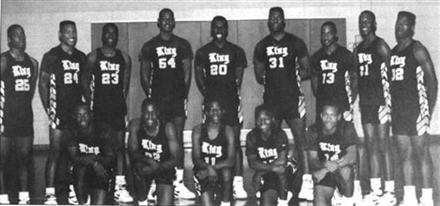
Sonny Cox's 1990 King team ranks as one of the best ever from the Windy City.
In 1990, King, which was located in the heart of gang territory, rose above the mean streets on Chicago's South Side to national prominence, recording a 32-0 season and a Class AA state title.
Cox's squad was stockpiled with gifted players. The team's leader was Jamie Brandon, a senior who ranked alongside Anfernee Hardaway, Grant Hill and Shawn Bradley as one of the nation's top prospects. He ultimately decided on LSU.
The Jaguars also featured Division I talent at forward with Johnny Selvie and point guard with Ahmad Shareef. However, the team's X-Factor for a March Madness game would have been freshman Rashad Griffith. A 7-foot prodigy, Griffith was a much ballyhooed basketball phenom in middle school, and a huge presence defensively for King as a ninth-grader.
Griffith, a future first-round NBA draft pick, later led King to a state title in 1993, along with fellow 7-footer Thomas Hamilton. With his defensive and rebounding contributions complementing the team's explosive scoring, the 1990 Chicago King team would have been a difficult first-round matchup for any collegiate team that lacked either stellar guard play or a true interior presence. King had both.
Continue reading{PAGEBREAK}
6. 2004 Oak Hill Academy (Mouth of Wilson, Va.)To call Oak Hill Academy a high school is a bit of a misnomer; it's more of a basketball breeding ground, an epicenter of incredible individual talent and an outstanding collection of teams.
Head coach Steve Smith has had several teams that people consider to be his best. His legendary 1993 squad featured Jerry Stackhouse and Jeff McInnis, and certainly has its place in Oak Hill history. The 2006 squad that featured Tywon Lawson and Michael Beasley would almost certainly have been undefeated if Kevin Durant stayed with the Warriors.
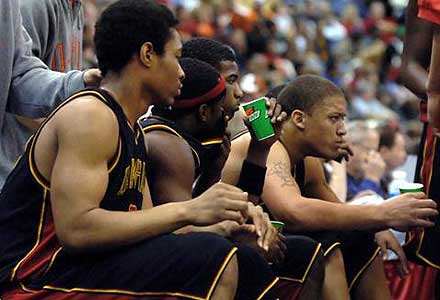
The 2006 Warriors team featured both Ty Lawson and Michael Beasley, but was not as dominant as the 2004 Warriors.
Photo by Jim Owens
Durant transferred out as Beasley transferred in, and ended up leading Montrose Christian (Md.) (along with current Maryland star Greivis Vasquez) to a buzzer-beater upset of Oak Hill at the close of the 2006 season.
Either of those squads would have presented challenges to more than a handful of college teams, but the Warriors squad that would have done the most damage in the NCAA tournament is the 2004 Oak Hill team.
Reloading after a 2003 season which saw them lose an uncharacteristic four games, the Warriors welcomed both Rajon Rondo from Kentucky and Josh Smith from Georgia. It would prove to be a perfect combination, as Oak Hill went 38-0 in 2004.
That season, Smith set the school's all-time scoring record with 980 points, averaging nearly 26 a night. Appropriately, Rondo set the school's all-time assist record, notching 494, good for 13 per game. Amazingly, he set another school record with 31 assists in a single game, breaking his own record of 27 that he achieved earlier in the year
Not impressed? How about 6-5 wing man (and current Clemson standout) K.C. Rivers' school record 15 3-pointers in one game. The team also featured five other future Division I players, including DayShawn Wright (Syracuse) and Anthony Wright (Michigan).
It's not hard to imagine how the 2004 Oak Hill team would have been a tough first round opponent for some college teams. Josh Smith, the quickest player to 500 blocks in NBA history, would have quelled most teams' interior play. Offensively, his ferocious dunks would have intimidated players three or four years his senior.
On the perimeter, Rondo and the rest of the backcourt may have been beaten occasionally on defense by some more physical guards, but would have been quick enough to create off the dribble offensively.
Head coach Steve Smith has faced plenty of teams with NBA talent, let alone Division I players. His 2004 team would not have been intimidated, and would not have gone home after its first game.
Continue reading{PAGEBREAK}
5. 2006 Lawrence North (Indianapolis)Aside from LeBron James, no player this decade has been more famous before graduating high school than Lawrence North's Greg Oden.
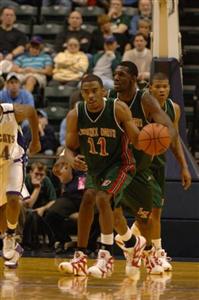
Mike Conley and Greg Oden
teamed up at Lawrence North
before heading to Ohio State.
Photo courtesy of the IHSAA
The 7-footer stands out in Indiana history as the state's most dominant center on both sides of the ball. He flourished under the tutelage of Lawrence North head coach Jack Keefer.
It's a good thing that Oden is unselfish; his teammate, point guard Mike Conley, was nearly every bit as talented, albeit sometimes overshadowed. He was also quick to share the ball, but it wasn't for a lack of his own offensive prowess.
"Conley could score at will," said MaxPreps Senior Writer Dave Krider, who has documented the careers of Oden and Conley in his book, Uncaged: The Rise of Greg Oden, Mike Conley, and the national champion Lawrence North Wildcats.
In 2003, Oden and Conley simultaneously became the first freshmen to start for head coach Jack Keefer, and the two have been inextricably linked ever since. After back-to-back state titles, 2006 had all the makings of a dream season, and the Wildcats — namely Oden and Conley — did not disappoint.
Lawrence North steamrolled through in-state competition. In its marquee out-of-state matchup against Jon Scheyer and Glenbrook North (Ill.) in Evanston, Ill., the Wildcats went on the road and beat the nationally ranked Spartans in front of a capacity crowd.
The Wildcats also received contributions from Damian Windham, a 6-5 junior who hounded down rebounds, and scrappy defender Brandon McDonald. Point guard Qadar Owen assisted Conley with ballhandling duties, and 6-8 freshman Stephan Van Treese, a senior currently committed to the University of Louisville, backed up Oden at center.
But it was Oden and Conley that would have made the 2006 Lawrence North squad a contender in the tournament's early rounds.
"Oden was the best big man that Indiana's ever had, and Conley's the best point guard Indiana's ever had," Krider said.
Perhaps the best evidence that Lawrence North's excellent duo would have advanced the Wildcats is the performance that the pair put forth in the 2007 NCAA Tournament. As mere freshmen, they were instrumental in leading Ohio State to the title game.
As high school seniors in 2006, they would have would have led Lawrence North, arguably the greatest team in state history, to a first-round win.
Continue reading{PAGEBREAK}
4. 1993 Simon Gratz (Philadelphia, Pa.)Philadelphia is as fertile a ground for basketball as any other city in the United States. Its list of hoops alumni reads like an NBA All-Star weekend program. It also includes two basketball immortals, Wilt Chamberlain and Kobe Bryant.
It comes as no surprise that Philadelphia's high schools have produced some outstanding teams. Aside from the great Overbook teams of the 1950s, no Philadelphia team would have had more success making it through the first round of the NCAA tournament than the 1993 Simon Gratz team.
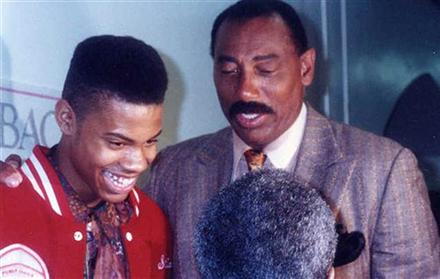
Rasheed Wallace, pictured with fellow Philadelphia legend Wilt Chamberlain, was the focal point of an unstoppable 1993 Simon Gratz team.
Photo courtesy of Ted Silary
A 31-0 record and a Public League championship only begin to tell the story of the greatness of head coach Bill Ellerbee's Bulldogs.
Not only did Gratz have a slew of Division I guards and forwards, it had a centerpiece (figuratively and literally) that made it truly dominant: 6-11 center Rasheed Wallace.
Wallace was a man amongst boys. He averaged 16 points, 15 rebounds, and seven blocks per game, despite spending many fourth quarters on the bench with the game's outcome already decided.
If Wallace's talent wasn't enough to intimidate opposing teams, the nascent reputation of his temper was. Wallace remains the only player to ever have been ejected from the McDonald's All-American game.
With constantly being double-teamed, Wallace unselfishly got his teammates involved — and they rose to the occasion. Second team all-city selection Rondell Turner actually led the team in scoring. Fellow forward Jamahal Redmond was also a key cog in the Gratz attack. Lynard Stewart (6-10), who went to Temple, also saw some minutes.
The team's guard play was almost equally impressive. Junior Shawn "Reds" Smith was a second team all-city selection who played at LaSalle. Sophomore Terrel Stokes would later head to Maryland. Alem Watson, who started at guard, could certainly hit a big 3-pointer in a pressure situation.
All of the Gratz's players jelled beautifully, especially in the playoffs, winning the city semifinals and finals by a combined 38 points.
Even against many college teams, Wallace would have controlled the middle — on both ends. He averaged nearly 10 points and seven rebounds playing less than 20 minutes in the ACC a game as a freshman at UNC.
Believe it or not, the 1993 Gratz team would've sent a mid-major team home, perhaps even Penn, a 14 seed that year.
Continue reading{PAGEBREAK}
3. 1990 Southwestern (Detroit)Most college basketball fans are familiar with the Fab Five — Michigan's quintet of talented freshmen that featured four future NBA players and captivated college basketball in 1991-1992.
How many fans are familiar with Detroit's Southwestern Prospectors, who captivated high school basketball in 1990 and featured three future NBA players?
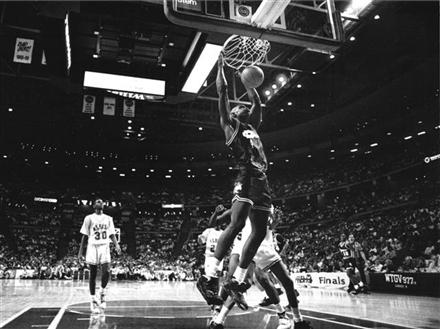
Chris Webber was one of the country's top players at Detroit Country Day, but he nearly attended Southwestern.
Photo courtesy of The Write Referee, LLC
Perry Watson's 1991 squad, which featured seniors Jalen Rose and Voshon Leonard, may have gotten the recognition as the country's top team. But it was the school's 1990 squad, that featured Rose, Leonard, and senior Howard Eisley, that laid the groundwork for the national acclaim.
"That 1990 team would rip your face off before they let you score a basket," said T.C. Cameron, an expert on Michigan high school sports whose upcoming book, Metro Detroit's High School Basketball Rivalries, features the Southwestern team.
According to Cameron, the 1990 team had a hunger for success that was unmatched, brought about by years of failure in the state playoffs.
"After seven losses in the title game of the previous eight seasons, Eisley, Leonard and Rose delivered coach Watson's first championship in the 1990 Class A Finals, a 67-54 victory at The Palace of Auburn Hills," Cameron wrote.
While Eisley and Leonard were sensational in their own right, it was Rose who starred for the Prospectors. He was fearless and confident, traits he picked up while playing on Detroit's city playgrounds. According to Cameron, Rose would dribble down the court, shoot a 25-foot 3-pointer, and turn to head back down the court while the ball was still in the air.
The UNLV Runnin' Rebels, who also featured three future NBA players, won the tournament in 1990 by blowing out Duke 103-73. In all likelihood, the 1990 Southwestern team would have taken down a first-round opponent thanks to its mix of talent and tenacity.
What's even scarier is that Fab Five member Chris Webber, who was a junior at the time, was best friends with Rose; many anticipated him to enroll at Southwestern. Had he not chosen instead to attend Detroit Country Day, he could have been on the 1990 team as well. At that time, he was the best high school player in the country.
Even sans Webber, there's no doubt that Southwestern was more talented than some college teams; their guard play would have given most teams fits, and would have been enough to give the Prospectors a shot at the Sweet 16.
Continue reading{PAGEBREAK}
2. 1989 St. Anthony (Jersey City, N.J.)While the rest of the country took note of the unblemished, uncontested national champion St. Anthony Friars last season, Friar faithful knew that their team, as outstanding as it was, would probably come up a hair short when ranking the top St. Anthony teams of all time.
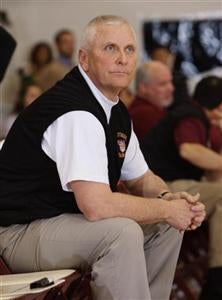
Bob Hurley would have coached his
1989 team to a first round victory.
Photo by Kevin Yen
Though Dominic Cheek, Tyshawn Taylor, Mike Rosario and the rest of the 2008 Friars would have more than held their own against the undefeated teams of 1996 and 2004, the 1989 St. Anthony team probably would've gotten the better of them.
The 1989 squad featured Bobby Hurley (son of legendary St. Anthony coach Bob Hurley), Terry Dehere and Rodrick Rhodes, each of whom was a first-round NBA draft pick.
Hurley was New Jersey's premier guard, and one of the best in the country that year. His ability to excel in the NCAA Tournament was clear in his time at Duke, leading the Blue Devils to the Final Four three times.
Dehere first started in 1989 but he excelled as well, earning a scholarship to Seton Hall and finishing his collegiate career with almost 2,500 points.
Rhodes was merely a freshman, but his talent was clear. By the time he was a senior, he was a top-five recruit in the country, and eventually slid into the starting lineup at the University of Kentucky as a true freshman.
Jerry Walker, who like Dehere played for Seton Hall, was an ultra-intimidating forward. At 6-7 and 240 pounds, Walker displayed the physical attributes and aggressiveness atypical of high school post players. He was one of the nation's best forwards, and helped the Pirates win two Big East titles.
After getting upset by neighborhood rival Ferris late in the 1988 season, St. Anthony returned the next season with a vengeance. The Friars beat nationally acclaimed Miami Senior (Fla.) and Flint Hill (Va.) They also knocked off state rival Elizabeth (N.J.), and captured the inaugural Tournament of Champions.
That Elizabeth team featured 7-1 Luther Wright, who began his career on St. Anthony before transferring.
His presence alongside Jerry Walker would have made the 1989 team even better. But the presence of another 7-footer would have made the 1989 St. Anthony team a hands-down favorite for best ever.
Shaquille O'Neal spent part of his childhood growing up in Bayonne, which borders Jersey City. As part of a military family, O'Neal moved around frequently, and even spent time in Germany before his stepfather relocated to the San Antonio army base where Shaq attended high school.
Local legend has it that O'Neal's family was close to relocating back to New Jersey, and that O'Neal would have attended St. Anthony. As it worked out, he and Hurley played together at the McDonald's All-American game.
Even without O'Neal, Hurley Sr. would have mapped out a top notch game plan for his collegiate opponent, utlizing his team's depth and riding his talented trio of guards and bruising post player to victory.
Continue reading{PAGEBREAK}
1. 2003 St. Vincent-St. Mary (Akron, Ohio)The player who could have had one of the single greatest collegiate basketball careers never played a single minute in a college game.
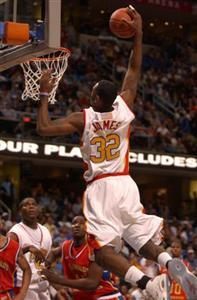
LeBron James could have notched
an opening-round victory.
Photo courtesy of Golin Harris
LeBron James did not succeed in March Madness solely because he opted for the NBA draft. Had he played even one year in college, he would have had a Carmelo Anthony-like impact in the tournament. Actually, had James' 2003 St. Vincent-St. Mary team been placed in the bracket, he still would've had success.
Everyone is well aware of how utterly dominant James was in high school, from the time he first solidified his spot at the nation's top player when he out-dueled Lenny Cooke, then regarded as the country's best player, in a summer camp showdown.
Here's something that very few people realize about his St. Vincent-St. Mary Fighting Irish: James' teammates were very good.
Forward Romeo Travis, one of James' lifelong friends, was a great scorer and crucial rebounder. He averaged 14 points and seven boards. The program's second all-time leading scorer, Marcus Johnson, was only a freshman on the 2003 team, but was still a scoring threat.
Helping to ease the pressure on LeBron was point guard Dru Joyce III. Joyce, who went to play at Akron alongside Travis, averaged more than 10 points and six assists per game. His poise helped to free up James, whose 6-8 frame even in high school was more developed than most college players.
Also physically imposing was Sian Cotton, whose aggressiveness and 6-4, 315-pound frame helped him win a scholarship to Ohio State to play football.
Guards Brandon Weems and Corey Jones, both of whom went on to play at Walsh University, could have done damage in a tournament game. Jones' 3-point range was frightening. He shot nearly 49 percent on 3-pointers and would have knocked down open attempts as tournament teams collapsed on James.
The Fighting Irish criss-crossed the country dominating high caliber opponents that year, beating the likes of Oak Hill Academy (Va.), Mater Dei (Calif.) and Westchester (Calif.), a game in which James ripped off 52 points.
Any tournament team preparing to play the 2003 St. Vincent-St. Mary team would have keyed on James, perhaps running a box-and-one to force other players to score. His teammates would have contributed, and no team would have been able to keep James from impacting the game. The 2003 Fighting Irish would have been a Sweet 16 Cinderella team.
E-mail Steve Spiewak at sspiewak@maxpreps.com. Dave Krider, Kevin Askeland, Ted Silary, Tom Markowski and T.C. Cameron contributed to this story.